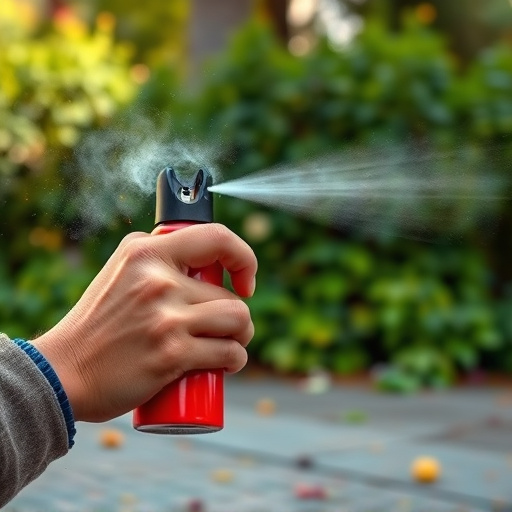Defensive pepper spray, with a typical range of 2-3 meters, temporarily disables attackers through eye and respiratory irritation. Its effectiveness depends on capsaicin concentration, formulation, and environmental conditions. Legal considerations vary by region, so understanding local guidelines regarding use, concentrations, and possession is crucial. Proper storage and user training, including de-escalation techniques, ensure safe and effective deployment within the recommended distance range.
Personal security is a top priority, especially in today’s unpredictable world. One effective tool to consider is the defensive pepper spray canister. This article guides you through essential aspects of these powerful self-defense mechanisms. We’ll explore the fundamentals of defensive pepper spray, including its distance range and effectiveness. Learn about legal considerations, safe handling practices, and optimal use training for maximum protection. By understanding these key factors, you can make an informed decision regarding this valuable personal security tool.
- Understanding Defensive Pepper Spray Basics
- Factors Affecting Spray Distance Range
- Legal Considerations and Permits
- Safe Handling and Storage Techniques
- Efficacy and Training for Optimal Use
Understanding Defensive Pepper Spray Basics
Defensive pepper spray is a powerful personal security tool designed to incapacitate an attacker temporarily, providing users with time to escape or defend themselves. At its core, defensive pepper spray works by irritating the eyes and respiratory system of the target, leading to temporary blindness, coughing, and difficulty breathing. This non-lethal force option has gained popularity among individuals seeking to enhance their personal safety, especially in situations where self-defense against a physically larger or more aggressive assailant is necessary.
The effectiveness of defensive pepper spray lies in its distance range, which typically allows users to deploy it from several meters away. This strategic factor enables individuals to activate the spray as a deterrent or retreat safely when facing an imminent threat. Understanding the defensive pepper spray distance range is crucial for optimal usage, ensuring that users can deploy it effectively while maintaining their own safety.
Factors Affecting Spray Distance Range
Several factors determine the defensive pepper spray distance range, which can vary significantly among different products. One key factor is the concentration of capsaicin, the active ingredient causing the burning sensation. Higher concentrations allow for a longer effective reach. The spray’s formulation and aerosol properties also play a role; fine mist sprays typically disperse more quickly but over a shorter distance compared to thicker, denser clouds of spray.
Moreover, environmental conditions can substantially impact spray performance. Wind direction and speed, temperature, humidity, and atmospheric pressure all influence how far the pepper spray travels. In windy conditions, for instance, the spray’s trajectory may be disrupted, reducing its effective range. Conversely, colder temperatures can cause some sprays to solidify or reduce their aerosolization, while high humidity might affect the spray’s concentration by diluting it.
Legal Considerations and Permits
When carrying a personal security inflammatory spray canister, understanding legal considerations is paramount. The use and possession of defensive pepper spray are regulated differently across jurisdictions, with laws varying based on state or regional guidelines. Key factors include permitted use scenarios, allowed concentrations, and restrictions on who can possess and carry such devices.
It’s crucial to know the defensive pepper spray distance range and other legal stipulations specific to your area. Some regions mandate permits for carrying pepper spray, while others may have limitations on the amount you can possess or require registration. Staying informed about these regulations ensures compliance and enhances personal security without crossing into illegal territory.
Safe Handling and Storage Techniques
Proper handling and storage of a personal security inflammatory spray canister are essential for ensuring its effectiveness and safety. When carrying the canister, always keep it in an accessible yet secure location on your person. Avoid placing it in pockets or bags where it could be easily damaged or inaccessible during an emergency. Hold the canister upright, as any liquid contents can spill if inverted.
For storage, keep the canister out of direct sunlight and extreme temperatures, which can degrade its performance. Store it away from heat sources, open flames, and other potential hazards. Ensure it is locked in a secure cabinet or area to prevent unauthorized access. Remember that the defensive pepper spray distance range varies by product, so familiarize yourself with the recommended usage guidelines to maximize its effectiveness during self-defense situations.
Efficacy and Training for Optimal Use
The effectiveness of a personal security inflammatory spray canister greatly depends on the user’s training and their ability to deploy it accurately within the recommended defensive pepper spray distance range, typically between 2-3 meters (6-10 feet). Proper training ensures that individuals can maximize the impact of the spray by aiming for the eyes, nose, and mouth—sensitive areas that will temporarily disable an attacker.
Regular practice sessions are crucial to maintain proficiency and ensure users can activate the canister effectively under stress. This includes learning proper hand placement, trigger control, and understanding the wind dynamics to improve accuracy, especially in close-quarters combat scenarios. Users should also be trained on de-escalation techniques to avoid unnecessary confrontations and only use pepper spray as a last resort.
Personal security inflammatory spray canisters, while effective in deterring potential threats, their performance heavily depends on factors like application technique, distance, and environmental conditions. Understanding the optimal defensive pepper spray distance range (typically 2-3 meters) is crucial for effective self-defense. Legal considerations and permits vary by region, so it’s essential to familiarize yourself with local regulations. Safe handling and storage techniques ensure the canister remains viable for when you need it most. Regular training enhances your ability to use the spray effectively, maximizing its efficacy in high-stress situations. Remember, proper knowledge and preparation can significantly improve personal security outcomes.
